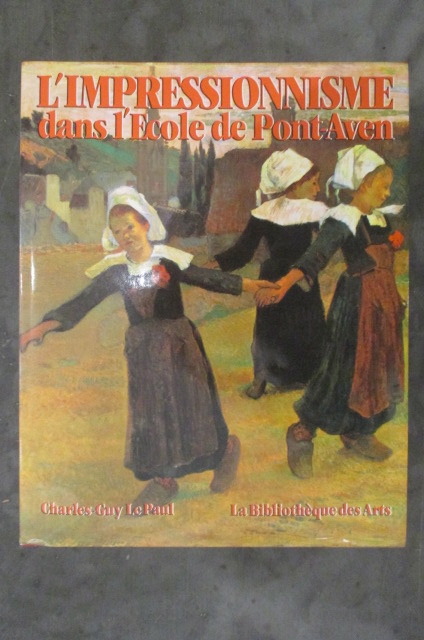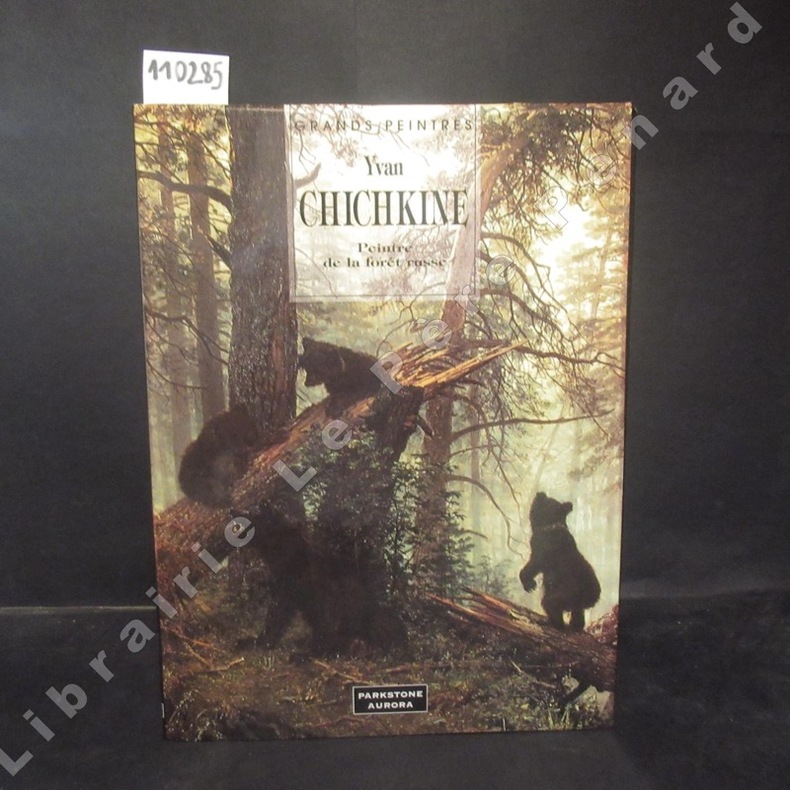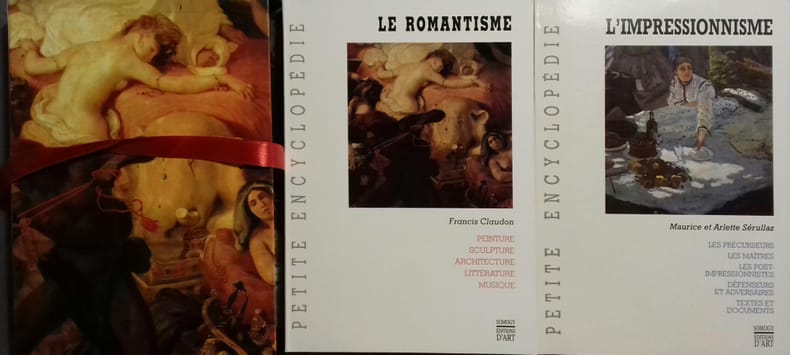|
Cezanne - MICHELI, Mario de
CEZANNE - Barcelona 1968 - Muy ilustrado
Barcelona, Edit. Toray, 1968. 76 ilustraciones en color fuera texto. 39p. de texto. 8º. Rústica editorial ilustrada. Dos páginas desprendidas. Buen ejemplar.
|
|
|
CEZANNE - RAYNAL Maurice,
Cézanne
Numerose illustrazioni a colori applicate. Bibliografia . 16mo. pp. 140. . Perfetto (Mint). . . .

|
|
|
CEZANNE - Riviere Georges,
Cézanne le peintre solitaire
60 reproductions dont 8 en culeurs . 16mo. pp. 182. . Ottimo (Fine). . Prima edizione (First Edition). .

|
|
|
CEZANNE, Paul (Aix-en-Provence, 1839 - Aix-en-Provence, 1906),
Cezanne
Testo di Francis Jourdain. Con 24 tavole a colori . 8vo. pp. 32 + tavole. . Molto buono (Very Good). Dorso spaccato (Cracking spine). . .

|
|
|
CEZANNE, Paul (Aix-en-Provence, 1839 - Aix-en-Provence, 1906),
Cézanne les dernières années (1895-1906)
Catalogo di mostra, Parigi, 20 aprile - 23 luglio 1978. A cura di Hélène Adhemar. Introduzione di William Rubin. Tavole a colori e in bianco e nero. Biografia. Bibliografia . 8vo. pp. 254. . Molto buono (Very Good). . . .

|
|
|
CEZANNE, Paul (Aix-en-Provence, 1839 - Aix-en-Provence, 1906)
Cézanne
Testo di Fritz Novotny. 113 tavole a piena pagina di cui alcune a colori applicate e 2 foto di Paul Cézanne . Cm 37x27. pp. 2 - tavole. . Molto buono (Very Good). . Prima edizione (First Edition). .

|
|
|
CEZANNE, Paul (Aix-en-Provence, 1839 - Aix-en-Provence, 1906),
Cézanne
Catalogo di mostra, Parigi, Galeries nationales du Grand Palais, 25 settembre 1995 - 7 gennaio 1996; Londra, Tate Gallery, 8 febbraio - 28 aprile 1996; Filadelfia, Philadelphia Museum of Art, 26 maggio - 18 agosto 1996. Testi critici. Opere divise e illustate in ordine cronologico: Gli anni sessanta, settanta, ottanta, novanta, dal 1900 al 1906. Cronologia; I collezionisti di Cezanne da Zola ad Annenberg; Bibliografia, Elenco delle esposizioni, Indice delle opere esposte. Con numerose tavole a colori fuori testo e illustrazioni. Edizione in francese . 4to. pp. 600. . Ottimo (Fine). . . .

|
|
|
CEZANNE, Paul (Aix-en-Provence, 1839 - Aix-en-Provence, 1906),
Cézanne. Il padre dei moderni
Catalogo di mostra. Complesso del Vittoriano, Roma, 7 marzo - 7 luglio 2002. A cura di Maria Terera Benedetti. Scritti di: C. Strinati, R. Barilli, F. Baumann, G. Boehm, D. Coutagne, M. Iseki, G. Mori. Con illustrazioni in nero e a colori. Biografia e bibliografia . 4to. pp. 232. . Perfetto (Mint). . Prima edizione (First Edition). .

|
|
|
CEZANNE, Paul (Aix-en-Provence, 1839 - Aix-en-Provence, 1906),
Disegni di Cézanne
Catalogo di mostra, Palazzo Braschi, Roma, 13 febbraio - 30 marzo 1979. Introduzione di Nello Ponente. 151 tavole in bianco e nero. Breve biografia, catalogo delle opere esposte. Bibliografia . 8vo. pp. 144. . Molto buono (Very Good). Firma di appartenenza al frontespizio (Owner's name on the title-page). . .

|
|
|
CEZANNE, Paul (Aix-en-Provence, 1839 - Aix-en-Provence, 1906),
Lettere (1864-1906)
A cura di Duilio Morosini ed Ernesto Treccani. Con 66 tavole in bianco e nero fuori testo . 8vo. pp. 142. . Molto buono (Very Good). . . .

|
|
|
CEZANNE, Paul (Aix-en-Provence, 1839 - Aix-en-Provence, 1906),
Paul Cézanne
Testo di Adrian Stokes. Traduzione di M. Cinotti. 10 illustrazioni a colori applicate . 4to. pp. 26. . Molto buono (Very Good). . . .

|
|
|
CEZANNE, Paul (Aix-en-Provence, 1839 - Aix-en-Provence, 1906),
Paul Cézanne
A cura di Marcel Brion. Con numerose illustrazioni in nero e a colori . 4to. pp. 96. . Molto buono (Very Good). . . .

|
|
|
CEZANNE, Paul (Aix-en-Provence, 1839 - Aix-en-Provence, 1906),
Paul Cézanne. 1839-1906
Testo di Ellie Faure. Con 60 tavole in bianco e nero . 16mo. pp. 64. . Molto buono (Very Good). . . .

|
|
|
Cezanne, Paul - Felix A. Baumann [Herausgeber]
Cezanne and the Dawn of Modern Art. Edited by Felix A. Baumann, Walter Feilchenfeldt, Hubertus Hassner. Museum Folkwang, Essen, September 18, 2004 - January 16,2005.
Ostfildern-Ruit., Verlag Hatje Cantz., 2004. 29 x 25 cm. 239 S. OLeinen mit OUmschlag / Cloth with dust jacket., 33989A 1. Auflage. Verlagsfrisches, neuwertiges Exemplar/ Fine as new.
書籍販売業者の参照番号
: 33989AB

|
|
|
Cezanne, Paul - Rewald, John
Cézanne. Biographie.
Köln, DuMont Buchverlag, 1986. 4°. 33 x 27 cm. 287 Seiten. Original-Leinenband mit Original-Schutzumschlag.
書籍販売業者の参照番号
: 9001EB

|
|
|
CHAZAL, Gilles (sous la direction de)
D’Ingres à Cézanne - Le XIXè siècle dans les collections du Musée du Petit Palais
Paris Musées 1998 In-4 broché couv. rempliée illustrée, illustrations en couleurs, 344 pp. Très bon état.
書籍販売業者の参照番号
: 19477

|
|
|
Chauveau (Sophie)
Fragonard. L’invention du bonheur
Télémaque 2011 In-8 broché 23 cm sur 15. 413 pages. Bon état d’occasion.
書籍販売業者の参照番号
: 88753
|
|
|
Charles S. Moffett - Eliza E. Rathbone - Katherine Rothkopf - Joel Isaacson
IMPRESSIONISTS in WINTER. EFFETS DE NEIGE
1999 / 240 pages. Broché. Editions Philip Wilson.
書籍販売業者の参照番号
: ART2050M
|
|
|
Charles S. Moffett
Impressionist and Post-Impressionist Paintings in the Metropolitan Museum of Art
Harry N. Abrams 1998 In-4 relié 32 cm sur 26,4. 256 pages. Bon état d’occasion.
書籍販売業者の参照番号
: 58497 ISBN : 810981084
|
|
|
Charles-Guy Le Paul
L'IMPRESSIONNISME DANS L'ECOLE DE PONT-AVEN. Monet, Renoir, Gauguin et leurs disciples.
1983 / 282 Pages. Relié avec jaquette. Editions La Bibliothèque des Arts.
書籍販売業者の参照番号
: ART269M

|
|
|
CHAN Georges
Les peintres impressionnistes et le chemin de fer.
La Vie du Rail, 1955. Plaquette 24x26 cm, 20 pages, vignettes couleurs, un des 1000 exemplaires numérotés sur papier des Papeteries Grillet et Féau. Envoi.
書籍販売業者の参照番号
: CF387

|
|
|
Charles Kunstler
Les impressionnistes - Pissarro
Edité par PLANTYN /DELTA / KLUWER, 1974. (25x33,5cm.) 95pp. Relié. Quelques taches liées à l’usure, sur l’intérieur de la couverture et les première et dernière pages. Bon état général. Livre fourni en illustrations en couleurs.
書籍販売業者の参照番号
: ART1321M

|
|
|
CHAUVEAU, Sophie.
MANET - Le secret.
Paris, Telemaque, 2014. in-8°, 381 pages, broché, couverture illustrée en couleurs.
書籍販売業者の参照番号
: 43768
|
|
|
Chartrain-Hebbelinck, M.-J.
Peintres belges Lumière française
Musées royaux des beaux-arts de Belgique, Bruxelles, 1969. In-12, brochure agrafée, s.p. [35 pp. env.]. Préface, par Philippe Roberts-Jones, conservateur en chef - Introduction, par M.-J. Chartrain-Hebbelinck, collaborateur scientifique - Catalogue : Peintures et dessins [65 n°]. - Sculptures [3 n°] - Bibliographie succinte.
書籍販売業者の参照番号
: 1575

|
|
|
Chabot, G. (préface)
Rétrospective Théo van Rysselberghe
Musée des Beaux-Arts de Gand, 1962. In-8, agrafé sous couverture illustrée en noir, 30 pp. Théo van Rysselberghe 1962-1926, par G. Chabot - Catalogue restreint : Peintures [172 n°]. - Aquarelles, pastels et dessins [69 n°]. - Eaux-fortes [37 n°]. - Lithographies [8 n°]. - Sculptures [5 n°]. - Illustrations de livres [11 n°]. - ...
書籍販売業者の参照番号
: 1524

|
|
|
Chaix, Andrée
Les Martigues. [Öl auf Leinwand, gerahmt / oil on canvas, framed].
o.J. [3 Warenabbildungen]
書籍販売業者の参照番号
: 61244BB

|
|
|
CHAMEROT & RENOUARD (Illustration) / CH. LORILLEUX & Cie., Paris (Encres) / [Société des Artistes français]; Librairie d'art Ludovic Baschet (Éditeur)
EXPOSITION DES BEAUX ARTS: CATALOGUE ILLUSTRÉ DE PEINTURE ET SCULPTURE [Dix-Sixième Année, du] SALON de 1894. / EXPOSITION DES BEAUX ARTS: CATALOGUE ILLUSTRÉ DE PEINTURE ET SCULPTURE [Dix-Septième Année, du] SALON de 1895. - 2 Volumes in 1.
Paris, Librairie d'art Ludovic Baschet, Éditeur; (1894/1895). 287 (1) / 284 pages, illustrated throughout (over 1.100 images). - Somewhat later black halfcloth-binding with decently coloured boards; 8vo.(ca. 21,5 x 15 x 3,5 cm; ca. 1 kg.).
書籍販売業者の参照番号
: 1912120846xpkv
|
|
|
Chastel Andre
Seurat. L'opera Completa Di
Mm 240x315 Classici dell'Arte Rizzoli. Volume cartonato di pp. 120 con 64 tavole a colori e numerose illustrazioni in bianco e nero, sovraccoperta editoriale conservata. Presentazione di André Chastel. Opera in buone condizioni. SPEDIZIONE IN 24 ORE DALLA CONFERMA DELL'ORDINE.
|
|
|
CHAUVEAU, Sophie.
MANET - Le secret.
in-8°, 381 pages, broché, couverture illustrée en couleurs. Tres bel exemplaire. [DV-5]
|
|
|
CHERPIN Jean
Charles Devillié (1850-1905), peintre impressionniste.
Marseille, Arts et Livres de Provence, 1978. 22 x 28, 82 pp., illustrations en couleurs et en N/B, reliure d'édition pleine toile, bon état (couverture légèrement défraîchie).
書籍販売業者の参照番号
: 69906
|
|
|
CHOUVALOVA, Irina
Yann Chichkine. Peintre de la forêt russe.
1996 Editions Parkstone, Aurora, Collection "Grands peintres" - 1996 - In-4, cartonnage illustré, jaquette illustrée - sans pagination - Illustrations en couleurs hors-texte
書籍販売業者の参照番号
: 110285

|
|
|
CHUIMER Virginie et HUMBERT Chantal
Impressionnisme, les artistes et leur temps.
Paris, Sélection du Reader's Digest, 2003. 25 x 33, 238 pp., très nombreuses illustrations en couleurs, cartonnage d'éditions imprimé, très bon état.
書籍販売業者の参照番号
: 19119
|
|
|
Cikovsky, Nicolai
Winslow Homer. Watercolors.
(New York), Hugh Lauter Levin, (1991). 120 S. Mit 16 s/w Textabb. u. zahlr. farbigen, meist ganzseitigen Abb. Quer-4to (30 x 42 cm). OLn m. illustr. Orig.-SU.
書籍販売業者の参照番号
: 68573

|
|
|
CIPRIANI Renata (testo di),
Impressionisti francesi
31 tavole a colori e 8 ill. . 16mo. pp. 10 - tavole. . Molto buono (Very Good). . . .

|
|
|
CIPRIANI Renata -
Impressionisti francesi.
Milano, Garzanti, (anni '50) 16mo brossura editoriale con copertina illustrata a colori, pp. nn. (60 circa) con una tavola in antiporta e 38 tavole in nero e a colori, anche ripiegate e a pagina doppia (Serie Arte Garzanti) .

|
|
|
Claire Leblanc & Johan De Smet
BruxellesUne capitale impressionniste
Snoeck/musée des Impressionnismes, Giverny, 2014. In-4, broché sous couverture illustrée en couleurs, 159 pp.
書籍販売業者の参照番号
: 7561
|
|
|
CLAIRE DURAND-RUEL SNOLLAERTS, CHRISTOPHE DUVIVIER
CAMILLE PISSARRO. LE PREMIER DES IMPRESSIONNISTES
Catalogue de l'exposition présentée au Musée Marmottan, du 23 février au 2 juillet 2017. Première exposition monographique organisée à Paris depuis 36 ans.
書籍販売業者の参照番号
: ART2505M

|
|
|
Clay Jean
L'impressionnisme
Hachette Réalités Cartonné avec jaquette 1996 In-4° cartonnage de l'éditeur sous jaquette illustrée, 317 pp., très nombreuses oeuvres reproduites en couleurs in et hors-texte, quelques photographies en noir et blanc, préface de René Huyghe ; incidents minimes sur la jaquette, très bon état Livraison a domicile (La Poste) ou en Mondial Relay sur simple demande.
書籍販売業者の参照番号
: bj566

|
|
|
CLAUDON Francis - SERULLAZ Maurice - SERULLAZ Arlette
Le romantisme. L'impressionnisme (2 volumes)
Couverture souple. Broché. 304 et 287 pages.
書籍販売業者の参照番号
: 209180

|
|
|
CLARK Kenneth
French Landscapes
Catalogo di mostra, Marlborough Gallery, Londra ottobre - dicembre 1961. Testo di Kenneth Clark. Tavole in bianco e nero e a colori (opere di Pierre Bonnard, Eugène Boudin, Georges Braque, Gustave Caillebotte, Paul Cezànne, Jean-Baptiste-Camille Corot, Gustave Courbet, Andrè Derain, Raoul Dufy, Paul Guigou, Stanislas Lépine, Henri Matisse, Camille Pissarro, Paul Signac, Alfred Sisley, et al.). Catalogo delle opere. Lingua inglese . 8vo. pp. 100. . Molto buono (Very Good). . . .

|
|
|
Clark, Eliot - 1883 ? New York ? 1980
A couple sitting on a bench enjoying the sunset.
o.J. Black chalk, surrounded by one line, on handmade paper, signed in blue ?Eliot Clark?, verso studio stamp. 22,2:28,9 cm.
書籍販売業者の参照番号
: 110-H
|
|
|
Clark, Eliot - 1883 ? New York ? 1980
Autumn landscape with falling leafs.
o.J. Black chalk, surround by one line, on handmade paper, signed in blue ?Eliot Clark?, verso studio stamp. 29,4:22,5 cm.
書籍販売業者の参照番号
: 115-H
|
|
|
Clark, Eliot - 1883 ? New York ? 1980
City landscape at night.
o.J. Black and white chalk, surrounded by one line, on green paper, signed ?Eliot Clark?, verso studio stamp. 19,3:20,7 cm.
書籍販売業者の参照番号
: 116-H
|
|
|
Clark, Eliot - 1883 ? New York ? 1980
Clearing at the edge of the forest and big tree.
o.J. Black chalk, surround by one line, on handmade paper, signed in blue ?Eliot Clark?, verso studio stamp. 22,8:30,4 cm.
書籍販売業者の参照番号
: 112-H
|
|
|
Clark, Eliot - 1883 ? New York ? 1980
Group of trees and bushes in mountains.
o.J. Black chalk, on brown paper, signed with pencil ?Eliot Clark?, verso studio stamp. 22,7:30 cm.
書籍販売業者の参照番号
: 095-H
|
|
|
Clark, Eliot - 1883 ? New York ? 1980
High sky with clouds above a hill.
o.J. Black chalk, surround by one line, on handmade paper, signed and dated in blue ?Eliot Clark 1904?, verso studio stamp. 22,7:28,7 cm.
書籍販売業者の参照番号
: 096-H
|
|
|
Clark, Eliot - 1883 ? New York ? 1980
Hilly landscape and houses in winter.
o.J. Black and blue chalk, on brown paper, monogrammed 2EC?, verso studio stamp. 22,8:30,3 cm. ? Little damages in the margins.
書籍販売業者の参照番号
: 111-H
|
|
|
Clark, Eliot - 1883 ? New York ? 1980
Hilly landscape with tree and fences.
o.J. Oil, on brown paper, signed in blue ?Eliot Clark?, verso studio stamp. 17,4:25,7 cm. ? Little bit dirty along margins.
書籍販売業者の参照番号
: 092-H
|
|
|
Clark, Eliot - 1883 ? New York ? 1980
Hilly landscape with trees, in the foreground a brooke.
o.J. Black chalk, surround by one line, on brownish handmade paper, signed in blue ?Eliot Clark?, verso studio stamp. 22,5:29,3 cm.
書籍販売業者の参照番号
: 109-H
|
|
|
Clark, Eliot - 1883 ? New York ? 1980
Impression of a landscape with trees and water.
o.J. Brown chalk, on vellum (page of a sketch-book), monogram ?EC?, verso studio stamp. 12,8:18 cm.
書籍販売業者の参照番号
: 080-H
|
|